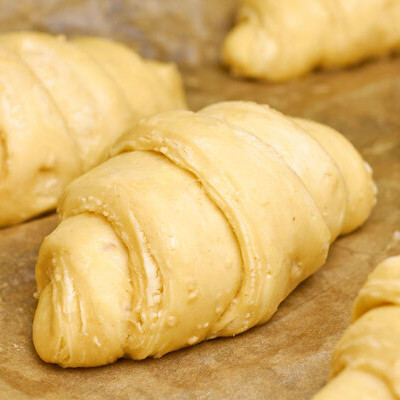
Dough Lamination
Also known as dough sheeting and dough folding
What is Dough Lamination?
Dough Lamination refers to the process of creating multiple, separate layers of dough and fat when making pastry. Under the lamination concept, the dough is wrapped around the fat, and then rolled out and folded over on itself many times to create layers of fat and dough.1
The lamination step is critical for creating the unique flaky texture of laminated baked goods, including:
- Pastry
- Croissants
- Soda crackers
Origin
Perhaps the lamination of dough emerged when Viennoiserie baked goods were created in Europe. Viennoiserie is the meeting point between pastry and bread. Professional bakers and pastry chefs around the world have used this term to refer to yeast-leavened doughs that are rich in sugar, butter and eggs.
The two major classes of Viennoiserie are laminated and non-laminated dough. Examples of laminated Viennoiserie include croissant, puff pastry and Danish, while versions of non-laminated Viennoiserie include brioche, Pan d’Oro, and Gibassier.
How it works
As the name suggests, lamination is the process of creating alternating layers of dough and “roll-in-fat” (butter, hard fats, margarine, shortening) to create light, tender and flaky pastries. There is usually a 30-min rest period between folds. Refrigeration of dough between folds, or maintaining a bakery room temperature of 60°F (15°C), is usually the rule to prevent fat from melting.1
In Danish pastry, fat is placed between two or three layers of fermented sweet dough and by repeated sheeting and folding methods, the fat layers are reduced to thin films separating dough layers. In these products, there are two principal leavening systems taking place, one from yeast and the other from expansion of the moisture and air entrapment in layers of dough and roll-in fat.
Lamination methods
- Three-fold (English) method: Dough is sheeted to ½ in (12.7 mm) thickness. Then ⅔ of the dough sheet surface is covered with roll-in-fat and then folded in thirds. This process initially yields 2 layers of fat within 3 separate layers of dough. Repeating the English method produces more layers of fat.
- Four-fold (book fold) method, also known as double-turn method: Here, the dough piece is sheeted slightly longer than the three-fold. Both ends are then folded over so that they meet slightly off-center. The folded dough piece is then again folded in half.
- Envelope method: Dough is sheeted into a square about 1 inch (25.4 mm) thick. Roll-in-fat is then shaped into a square and placed in the center of the dough sheet. Next, the corners of the dough sheet are folded to the center like an envelope.
Number of layers for various categories of laminated products
- Croissants: 24–144 fat layers
- Danish: 24–54 fat layers
- Puff pastry: 81–729 fat layers
Generating more layers requires:
- A stronger flour with higher protein content
- Higher roll-in-fat amount
- A more waxy or cohesive fat
- A more firm dough (lower hydration levels)
- Lower room temperatures to preserve the thin and delicate fat leyers
Application
The typical number of fat layers desired for Danish pastry is generally between 24 to 54 layers. High-speed bakers, using automated laminating equipment, tend to use 24 to 36 layers whereas retail bakers may add more layers.
If two fat layers are created at the initial rolling-in of the fat, and three 3-folds are applied afterwards, this would generate 54 fat layers.
Fat layers: 2 x 3 = 6 x 3 = 18 x 3 = 54.
Flour characteristics for best lamination results
- Alveograph P/L value: lower than 0.9 (too strong flours that are not properly hydrated may cause dough tearing during lamination)
- Alveograph W value: 250 to 300
- Wheat blends: Low-protein bread flour milled from HRW (hard red winter) wheat
- Protein content: 10.0 to 11.0% (14% moisture basis)
- Farinograph absorption (500 BU): 58.0–62.0%
- Farinograph development time: 4–7 minutes
References
- Suas, M. “Viennoiserie.” Advanced Bread and Pastry: A Professional Approach, Delmar, Cengage Learning, 2009, pp. 305–397.

